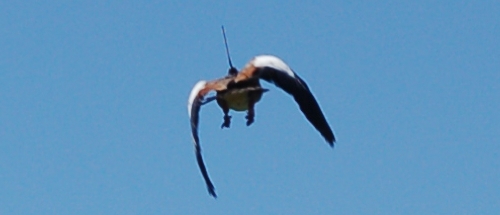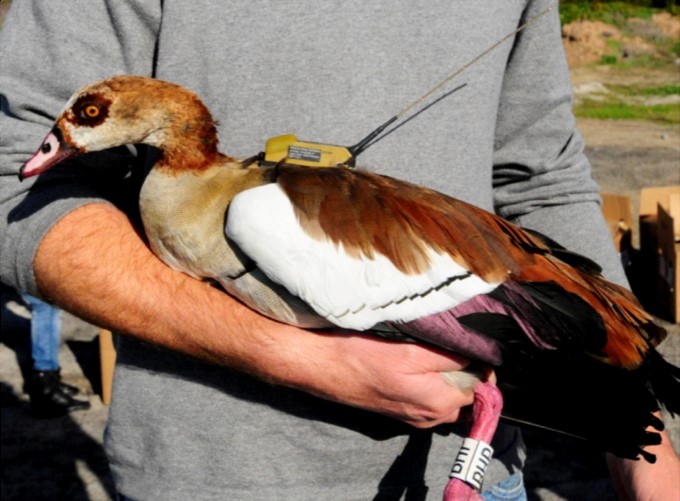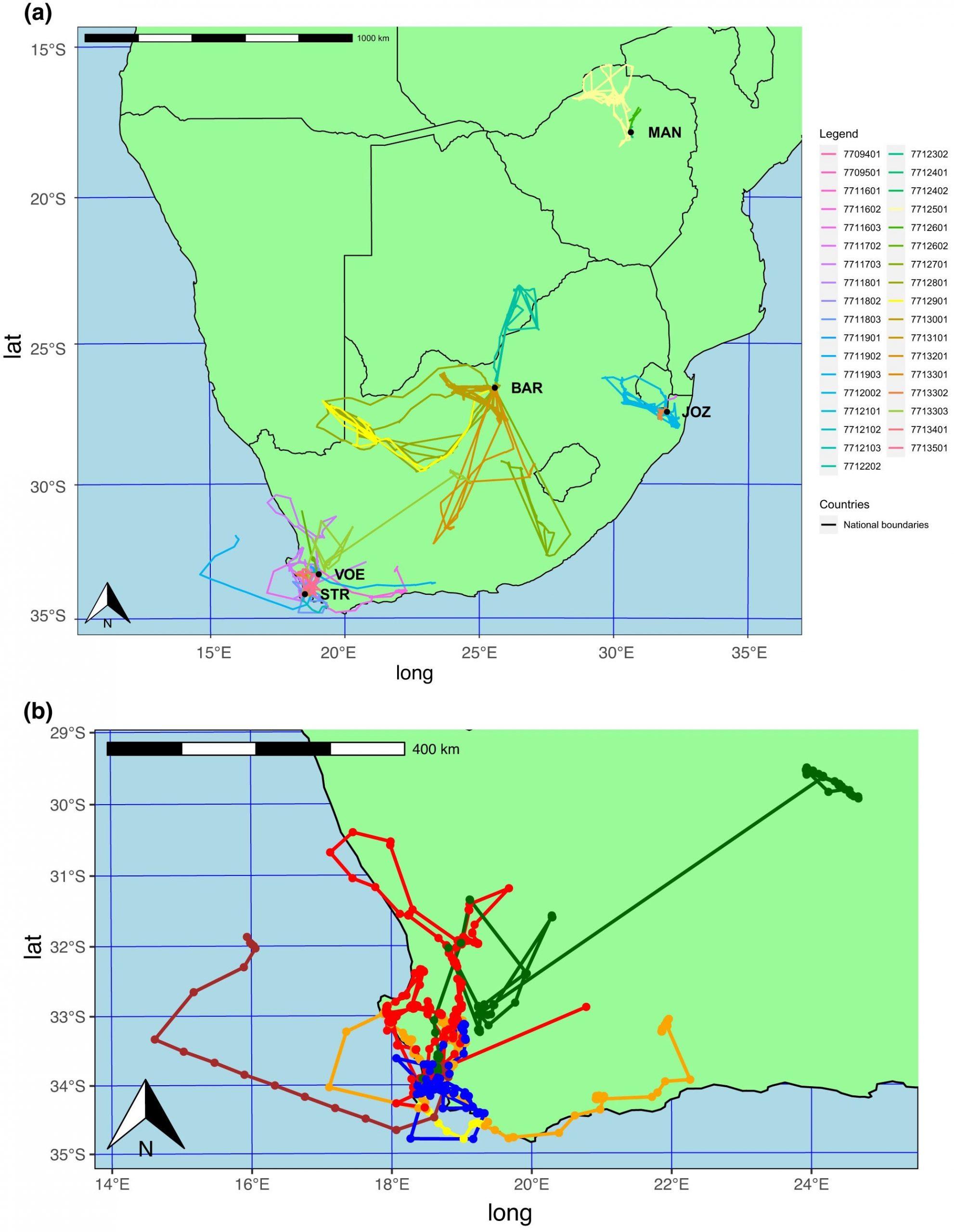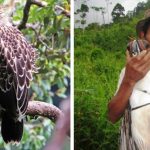← Back
How do Egyptian geese find their way?

One of the mysteries of migrant animals is their ability to find their way back and forth during their long-range travels. Several hypothesis were tested on Egyptian geese to try to understand their navigation capacity. It seems they learn their way around.
Photo: an Egyptian goose with an Argos PTT in flight (credit: G.S. Cumming)
Egyptian geese (Alopochen aegyptiacus) are found all over Africa except deserts (Sahara and Namib) and rainforests (central Africa). They are in fact shelducks, foraging on the edges of wetlands, on lawns and on young shoots in agricultural fields.
They move every year from their resident wetlands to and from a predator-safe wetland to which they show a high fidelity. There, they moult their flight feathers, a physiological and behavioural need which entails a 3–4-week period when they can’t fly and which they can’t delay for long. They return to their home area after moult. Their flexibility in those long-distance movement behaviours is unclear, though, and so is the form of navigation they use.

An Egyptian goose with an Argos PTT (credit: D.A.W. Henry)
Tracking Egyptian geese & study sites
Two leading hypotheses on migratory animal navigation are route-based navigation (they use information gathered during the outward journey to come back) or map-based navigation (they have a mental model of where they wish to go and follow a suitable route to a known destination and back).
Thirty-five adult Egyptian geese individuals were captured in the late stages of wing feather moult. Six of them were moved 1250 km south from a large wetland (Barberspan) in the North West Province of South Africa, to Strandfontein, in the Western Cape Province near Cape Town. The other 29 constituted the control group, captured at five different moulting locations (including the locations for the translocation experiment, Strandfontein and Barberspan, but not only) in South Africa and Zimbabwe.
The two sites, Barberspan and Strandfontein, were chosen as they are extensive wetland areas that are used by a large number of ducks for moulting. They are far apart, but not so far for a duck to move in several steps (they can fly up to at least 850 km/day). Moreover, the sites lie on a natural latitudinal gradient, meaning that birds with such capacities would be able to use the sun, stars or other cues to orientate. Records show that it is extremely uncommon for an Egyptian Goose to move from Barberspan to Strandfontein, although banded birds from one site have occasionally been recaptured at the other.
More info about animal tracking with Argos
Translocating Egyptian geese
After releasing the six translocated birds at Strandfontein, three different outcomes were considered plausible. Either the birds would return to Barberspan for their next moult, or to their breeding sites, thus showing evidence of map-based navigation. Alternatively, they might remain at Strandfontein and follow resident ducks, thus learning their way via route-based navigation. The last plausible outcome was that birds might try the same kind of movements from Strandfontein that they would have from Barberspan. This latter outcome would indicate a role for memory and past experience.
Over up to 658 days, none of the six translocated Egyptian geese returned to Barberspan and only one appeared to fly towards it. They did not seem to follow resident geese, either, but on the contrary exhibited unusual behaviours, flying over the ocean for a time, in particular, before turning back. Those searching-type movements were shown at the onset of both moult migration and the breeding season, when birds would limit their movements to the area round their nesting site.

Map of southern Africa, showing movement paths from (a) all 29 resident birds and 6 translocated birds; BAR, Barberspan; JOZ, Jozini Dam; MAN, Lake Manyame; STR, Strandfontein; VOE, Voelvlei. and (b) translocated birds only. Most of them went west or south, flying over the ocean for a time (from [Cumming et al., 2022])
Egyptian geese probably learn their routes
The fact they did not return to their usual moulting site shows that Egyptian Geese are not using environmental or celestial cues for their long-distance travel (map-based navigation thus excluded). The large variety of paths and the fact they differed from those of the resident ducks shows a lack of influence of both social and direct environmental cues.
The translocated geese moved mainly west or south after release, as they might have from Barberspan after completing moult. This suggests that translocated birds retained elements of learned behaviours. Two undertook long-distance travels, probably trying to return to their original breeding area, at a time matching their usual moulting period rather than local moult patterns of birds in their translocated area.
Such conservative learned behaviours may have prevented the natural spread of Egyptian geese into Europe, where they were introduced by humans and subsequently established breeding populations. If Egyptian Geese are typical of African species then a heavy reliance on learned behaviours raises concerns in a context of climate change and habitat modification. More generally, it questions the resilience and adaptive capacity of African waterfowl populations to habitat modification and climate change, such as the increasingly arid conditions predicted for South Africa.
Reference
Cumming, G. S., Henry, D. A. W., & Reynolds, C. (2022). Translocation experiment gives new insights into the navigation capacity of an African duck. Diversity and Distributions, 28, 1034– 1049. https://doi.org/10.1111/ddi.13510

